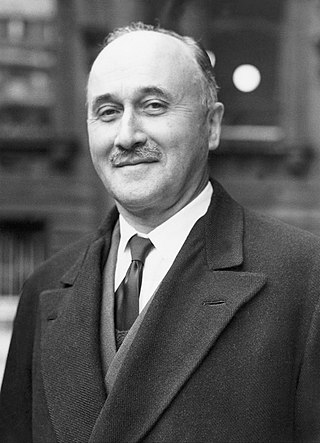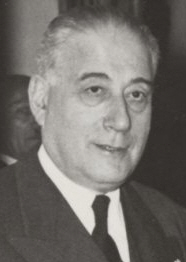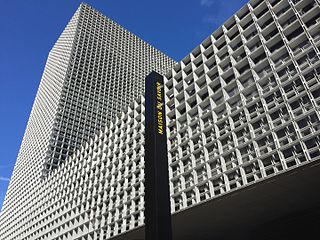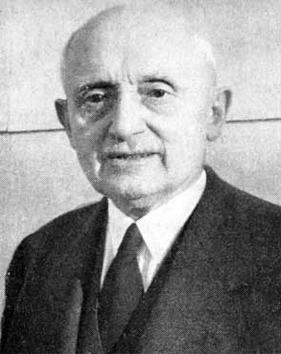
The European Coal and Steel Community (ECSC) was a European organization created after World War II to integrate Europe's coal and steel industries into a single common market based on the principle of supranationalism which would be governed by the creation of a High Authority which would be made up of appointed representatives from the member states who would not represent their national interest, but would take and make decisions in the general interests of the Community as a whole. It was formally established in 1951 by the Treaty of Paris, signed by Belgium, France, Italy, Luxembourg, the Netherlands, and West Germany and was generally seen as the first step in the process of European integration following the end of the Second World War in Europe. The organization's subsequent enlargement of both members and duties ultimately led to the creation of the European Union. However, it was forced into action in 1952.

The European Economic Community (EEC) was a regional organisation created by the Treaty of Rome of 1957, aiming to foster economic integration among its member states. It was subsequently renamed the European Community (EC) upon becoming integrated into the first pillar of the newly formed European Union (EU) in 1993. In the popular language, the singular European Community was sometimes inaccurately used in the wider sense of the plural European Communities, in spite of the latter designation covering all the three constituent entities of the first pillar. The EEC was also known as the European Common Market (ECM) in the English-speaking countries, and sometimes referred to as the European Community even before it was officially renamed as such in 1993. In 2009, the EC formally ceased to exist and its institutions were directly absorbed by the EU. This made the Union the formal successor institution of the Community.

The Treaty of Rome, or EEC Treaty, brought about the creation of the European Economic Community (EEC), the best known of the European Communities (EC). The treaty was signed on 25 March 1957 by Belgium, France, Italy, Luxembourg, the Netherlands and West Germany, and it came into force on 1 January 1958. Originally the "Treaty establishing the European Economic Community", and now continuing under the name "Treaty on the Functioning of the European Union", it remains one of the two most important treaties in what is now the European Union (EU).

The European Atomic Energy Community is an international organisation established by the Euratom Treaty on 25 March 1957 with the original purpose of creating a specialist market for nuclear power in Europe, by developing nuclear energy and distributing it to its member states while selling the surplus to non-member states. However, over the years its scope has been considerably increased to cover a large variety of areas associated with nuclear power and ionising radiation as diverse as safeguarding of nuclear materials, radiation protection and construction of the International Fusion Reactor ITER.

Jean Omer Marie Gabriel Monnet was a French civil servant, entrepreneur, diplomat, financier, and administrator. An influential supporter of European unity, he is considered one of the founding fathers of the European Union.

The European Communities (EC) were three international organizations that were governed by the same set of institutions. These were the European Coal and Steel Community (ECSC), the European Atomic Energy Community, and the European Economic Community (EEC), the last of which was renamed the European Community (EC) in 1993 by the Maastricht Treaty establishing the European Union. The European Union was established at that time more as a concept rather than an entity, while the Communities remained the actual subjects of international law impersonating the rather abstract Union, becoming at the same time its first pillar. In popular language, however, the singular European Community was sometimes used interchangeably with the plural phrase, in the sense of referring to all three entities.

The Luxembourg Compromise was an agreement reached in January 1966 to resolve the "Empty Chair Crisis" which had caused a stalemate within European Economic Community (EEC).

The Mayer Authority was the second High Authority of the European Coal and Steel Community (ECSC), between 1955 and 1958. Its president was René Mayer of France.

The Finet Authority was the third High Authority of the European Coal and Steel Community (ECSC), between 1958 and 1959. Its president was Paul Finet of Belgium.

The Malvestiti Authority was the fourth High Authority of the European Coal and Steel Community (ECSC), between 1959 and 1963. Its president was Piero Malvestiti of Italy.

The Del Bo Authority was the last High Authority of the European Coal and Steel Community (ECSC), between 1963 and 1967. Its president was Rinaldo Del Bo of Italy. Del Bo was briefly followed by Albert Coppé's interim Authority.

The year 1948 marked the beginning of the institutionalised modern European integration. With the start of the Cold War, the Treaty of Brussels was signed in 1948 establishing the Western Union (WU) as the first organisation. In the same year, the International Authority for the Ruhr and the Organization for European Economic Co-operation, the predecessor of the OECD, were also founded, followed in 1949 by the Council of Europe, and in 1951 by the European Coal and Steel Community, with the ensuing moves to create further communities leading to the Treaty of Rome (1957).

Belval is a quarter and neighbourhood in the west of Esch-sur-Alzette, in south-western Luxembourg. Belval is the site of the large steelworks that dominate the city. Due to the dominance of the steelworks, Belval suffered from the abandonment of steel production in Luxembourg, and is undergoing an extensive regeneration programme to help diversify beyond steel production. The redevelopment plan, priced at €450m, will turn the brownfield site into a large scientific and cultural centre, including the science faculty of the University of Luxembourg. It is the location of the Rockhal, Luxembourg's largest music venue, which opened in 2005.

The Messina Conference of 1955 was a meeting of the six member states of the European Coal and Steel Community (ECSC). The conference assessed the progress of the ECSC and, deciding that it was working well, proposed further European integration. This initiative led to the creation in 1957 of the European Economic Community and Euratom.

The Spaak Committee was an Intergovernmental Committee set up by the Foreign Ministers of the six Member States of the European Coal and Steel Community (ECSC) as a result of the Messina Conference of 1955. The Spaak Committee started its work on 9 July 1955 and ended on 20 April 1956, when the Heads of Delegation of the six Member States of the ECSC approved the Spaak report. The committee worked on two main topics, one was the creation of a general common market and the other one was the establishment of a European Community for the peaceful use of atomic energy.

The Benelux memorandum of 1955 was a document drafted by the three Benelux countries on 18 May 1955 as a means to reviving European integration on the basis of a general common market.

The High Authority was the executive branch of the former European Coal and Steel Community (ECSC). It was created in 1951 and disbanded in 1967 when it was merged into the European Commission.

Léon Daum was a French mining engineer, company director and senior European administrator. He was a member of the High Authority of the European Coal and Steel Community from 1952 to 1959.

The European Schools is an intergovernmental organisation, which has established, financed, and administered a small group of multilingual international schools, bearing the title "European School", which exist primarily to offer an education to the children of European Union (EU) staff; offers accreditation to other schools, bearing the title "Accredited European School", under national jurisdiction within EU member states to provide its curriculum; and oversees the provision of the secondary school leaving diploma, the European Baccalaureate.

The Action Committee for the United States of Europe, colloquially referred to as the Monnet Committee, was a collective initiative spearheaded by Jean Monnet from 1955 to 1975 that aimed at accelerating European integration through informal dialogue among key political and trade unions leaders. It was a civil society endeavor that lied outside of any formal policymaking process, but involved the direct participation of organizations that collectively wielded overwhelming decision-making power within its geographical scope, namely the participating countries of the European Coal and Steel Community and from 1958 of the European Communities.












